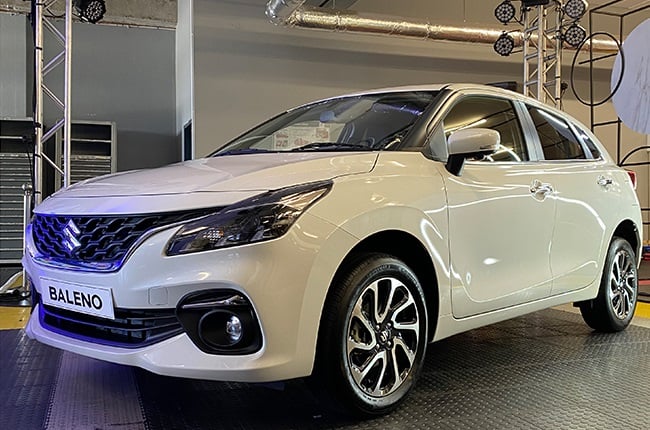- The Baleno range starts from R229 500.
- It is powered by a 1.5-litre engine that produces 77kW and 138Nm.
- Hill-Hold Control, Rear Parking Sensors and Cruise Control all come standard on the GL model.
The features found in a brand-new entry-level car now versus a decade ago are like comparing chalk and cheese. Must-haves on a MY2022 (model year) are an infotainment touchscreen, automatic climate control and parking sensors.
None of which you would’ve found on a base model ten years ago because that tends to be reserved for higher-specced or premium variants.
Justifiably, comparing cars from different decades is unfair as factors like technology and inflation play a vital part. This brings me to the Suzuki Baleno. How the Japanese brand priced its brand-new second-generation model at R229 500 with the standard features it comes out with is mighty impressive.
Besides Suzuki breaking sales records left, right and centre while outselling the top two automakers in the land in the process (passenger cars sales in May 2022), they’ve consistently put value-for-money offerings (Celerio, S-Presso, Swift, Jimny) on the table. They know their target market, and the team always has the brief nailed down where marketing is concerned. Others will follow.
The Baleno’s standard features
The R200 000 to R250 000 bracket is where most new buyers are looking, and there are vast options to choose from, including Suzuki’s Baleno. The Baleno competes against the Volkswagen Polo Vivo (priced from R237 000), its carbon-copy Toyota Starlet (priced from 226 200), and the Kia Picanto (priced from R198 995). Suzuki aims to sell 500 units a month in South Africa. One would think it’s an arduous task otherwise, but Suzuki is continually breaking sales records, so they’re not far off the mark, selling just under 500 units in July and August.
Some of the Baleno’s standard features include Hill-Hold Control, Rear Parking Sensors, Cruise Control and a Rearview Camera. By comparison, the Baleno and Starlet are the closest rivals (go figure, they’re the same car), and you don’t get many of the standard features in any other entry-level models in its price range. The Trendline Polo Vivo, for example, doesn’t come with Cruise Control, Hill-Hold Control or Parking Distance sensors, and it is pricier.
While Suzuki mainly kept the previous chassis, everything else is new, like the headlights, front grille, bumper, rear lights and 15-inch wheels (found on the GLX trim only). In addition to the existing Arctic White Pearl and Midnight Black Pearl, the colour palette now also features new options like Celestial Blue Pearl Metallic, Luxe Beige Pearl Metallic, Opulent Red Pearl Metallic, Splendid Silver Pearl Metallic and Grandeur Grey Metallic.
Boot space is rated at 314 litres, and the available storage space jumps to 1 057-litres with the rear seats folded down.
How does it drive?
The great thing about driving the Baleno is that it’s not a laptop on wheels, where you constantly need to fiddle around with settings and take your concentration off the road. The 7-inch display shows you what you need to know, like the radio and real-time fuel consumption, while featuring Apple CarPlay and Android Auto connectivity. When reversing, the screen doubles up as a rear-view camera display that works in unison with the park sensors.
SEE | First-time buyer? Here are 5 reliable used car options for under R2 000 a month
The aspirated 1.5-litre has power figures of 77kW and 138Nm, and the test unit was mated to a five-speed manual transmission – although a four-speed auto is also on offer. The engine is in its element around town and on highway bursts, though I noted that the fifth gear has a surprisingly short ratio because when you move closer to the 120km/h mark, the revs are already at 3000rpm. Either the ratios should be longer, or a sixth gear is needed.
Even with rear passengers, the engine doesn’t feel strained – it’s basically how you play with gears and adjust the speed. I’ve always been a fan of Suzuki’s (leather-trimmed) steering wheels, and in the Baleno, it’s firm and agile in the hands. The 955kg kerb weight definitely affects how easily the car handles, whether around traffic circles in Muizenberg or navigating corners on Chapman’s Peak Drive in Cape Town.
Just one little gripe…
No car is perfect, and the Baleno does have a pimple on its face. It is the lack of automatic locking, and especially with the rate of hijackings and theft in the country, I think that feature is imperative. It has to be drilled into your mind to remember to (manually) lock the door every time you get in and drive. The range is sold with a five-year or 200 000km mechanical warranty, including unlimited roadside assistance for the same period, a four-year or 60 000km service plan, and a six-year anti-corrosion warranty.








